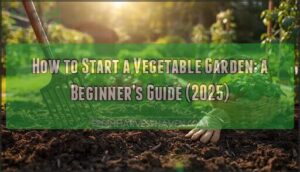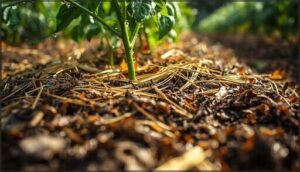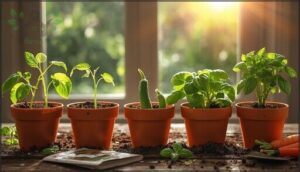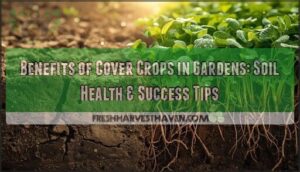This site is supported by our readers. We may earn a commission, at no cost to you, if you purchase through links.
Most first-time vegetable gardeners lose half their plants to preventable mistakes—usually before the first harvest. The difference between a thriving garden and a disappointing one often comes down to three decisions you make before you even touch a seed. Sunlight exposure, soil drainage, and strategic positioning determine whether your tomatoes flourish or your lettuce wilts by midsummer.
Learning how to start a vegetable garden means understanding these foundational elements first, not just buying whatever catches your eye at the nursery. Get the groundwork right, and you’ll spend less time troubleshooting and more time enjoying fresh produce from your backyard.
Table Of Contents
- Key Takeaways
- Choosing The Best Garden Location
- Preparing Soil for Vegetable Gardening
- Selecting and Planting Vegetables
- Top 5 Vegetable Seeds to Start Your Garden
- Frequently Asked Questions (FAQs)
- How to start a vegetable garden from scratch?
- How to start a vegetable garden?
- How do I choose a vegetable garden?
- How do I become a vegetable gardener?
- How do you start a vegetable garden in pots?
- How do you make a vegetable garden?
- What is the most common mistake of first time gardeners?
- What is the best vegetable garden for beginners?
- What is the best month to start a vegetable garden?
- What is the easiest vegetable to grow for a beginner?
- Conclusion
Key Takeaways
- Your garden’s success hinges on three pre-planting decisions—sunlight exposure (6+ hours daily), well-draining soil (1 inch per hour infiltration), and wind protection (40-70% reduction via barriers)—that determine whether crops thrive or fail before you ever touch a seed.
- Most first-time gardeners lose half their plants to preventable mistakes like skipping soil preparation, where adding 2-4 inches of compost annually boosts fertility by 50% and proper mulching cuts watering needs in half while stabilizing soil temperature.
- Starting with proven beginner crops like bush beans, radishes, lettuce, and compact varieties eliminates guesswork—these germinate fast (70-95% rates), tolerate mistakes, and deliver harvests in 30-60 days without fussy care requirements.
- Proper spacing (12-18 inches between rows) and companion planting (basil with tomatoes boosts yields 5-12%, marigolds slash pests 60%) transforms garden layout from crowded chaos into disease-resistant productivity that maximizes every square foot.
Choosing The Best Garden Location
Your garden’s success starts long before you plant a single seed—it all comes down to location. The right spot gives your vegetables the sunlight, drainage, and protection they need to thrive from day one.
Let’s walk through the four essential factors that’ll set your garden up for a superb growing season.
Full Sun Requirements for Vegetables
Before you break ground, understand this: your vegetables need at least 6 hours of direct sunlight daily to thrive. That sunlight hours commitment isn’t arbitrary—it drives photosynthesis rates and directly impacts crop yield optimization. Morning sun is especially valuable for vegetable gardening, as it warms your soil and dries dew, reducing fungal problems. Light intensity matters, too.
When you’re garden planning, remember that tomatoes and peppers demand 8-10 hours for peak performance, while lettuce tolerates partial shade. Insufficient sunlight can slash your harvest by 25-50%, so don’t compromise on this fundamental requirement for gardening for beginners establishing their first vegetable garden.
Understanding the complex moral dilemmas in gardening can also help you make informed decisions about your garden’s layout and maintenance.
Selecting Well-Draining Soil
Sunlight fuels growth, but waterlogged roots kill faster than shade ever will. Your garden soil needs drainage that lets water infiltrate at least 1 inch per hour—sandy loam works beautifully. Test it: dig a hole, fill it, and watch. If water sits for days, your soil texture needs help. Mix in 2-3 inches of compost to boost porosity levels and transform compacted earth into thriving garden soil that breathes. Understanding academic research methods can also help gardeners make informed decisions.
- Conduct a simple percolation test by digging a 12-inch hole and timing how fast water drains
- Amend heavy clay soils with coarse organic matter to create macropores for improved water infiltration
- Build raised beds if your existing soil requirements can’t be met through amendments alone
- Maintain soil health by adding compost annually to sustain drainage systems and support vigorous root development
Protecting Your Garden From Wind
Wind can slash your cucumber harvest by 20% and whip moisture right out of leaves before you notice. That’s why windbreak designs matter—strategic fencing or hedges drop gusts by 40–70%, curbing soil erosion and protecting tender foliage. Pair permeable barriers (30–50% porosity) with smart companion planting to encourage steady air movement without turbulent flow. Your crop protection starts at the garden’s edge.
| Windbreak Type | Wind Reduction |
|---|---|
| Half-height fence | 40–50% |
| Live hedge (arborvitae) | 50–60% |
| Multi-layer shrubs + trees | 60–70% |
| Temporary fabric screen | 30–40% |
Ensuring Easy Access and Water Supply
Once you’ve got shelter sorted, think about hauling a hose or watering can multiple times a week. Locating your plot near a faucet cuts irrigation time by 15 minutes per session—87% of gardeners rely on household water, so convenience matters.
Rain harvesting and soil moisture checks boost efficiency by 30%, turning watering tips into practical garden maintenance that keeps vegetables thriving without the heavy lifting.
Preparing Soil for Vegetable Gardening
Think of soil as the foundation of your entire garden—it’s where your vegetables will either thrive or struggle. Getting it right from the start means better growth, healthier plants, and a harvest you’ll actually be proud of.
Soil is the foundation where your vegetables will either thrive or struggle—getting it right from the start means better growth and a harvest you’ll be proud of
Here’s how to transform whatever patch of earth you’re working with into a nutrient-rich growing environment.
Adding Compost and Organic Matter
Think of compost as your soil’s best friend—it’s the foundation of thriving organic gardening. You’ll want to work in 2-4 inches annually, mixing it into the top 6-12 inches of soil during your soil preparation phase.
This boosts soil fertility by up to 50%, supercharges microbial activity, and creates the nutrient cycling your vegetables crave for explosive growth.
Removing Weeds, Rocks, and Debris
Before you plant a single seed, clear your bed of weeds, rocks larger than 2 cm, and debris—this soil preparation step is non-negotiable.
Weeding takes time but pays off; persistent weed control cuts seed banks by 40% over three seasons. Rock removal ensures proper root zone aeration, while debris clearance reduces algae formation by 20–30%, giving your garden design a clean, healthy start.
Improving Drainage and Soil Structure
Beyond clearing debris, you’ll want to tackle soil compaction and poor water infiltration head-on. Loosen compacted soil with a garden fork down to 12–18 inches—this simple soil preparation boosts drainage by 20–40%. Work in compost to build soil structure and improve aeration; studies show 2–4 inches increases porosity measurably.
For erosion control on slopes, raised beds cut runoff by up to 35%.
Using Mulch to Retain Moisture
Mulch benefits go way beyond aesthetics—it’s your secret weapon for water conservation. Spread 2–3 inches of organic matter like straw or shredded leaves around your plants, and you’ll slash watering by up to 50%.
Mulch stabilizes soil temperature, cuts evaporation by 70%, and steadily feeds moisture levels while keeping weeds at bay—essential soil preparation for vegetable gardening beginners.
Selecting and Planting Vegetables
Now that your soil’s prepped and ready, it’s time to choose what you’ll actually grow—and this is where things get exciting. The vegetables you select need to match your climate, your schedule, and honestly, what you want to eat.
Let’s walk through the key decisions that’ll set you up for a thriving first harvest.
Easy-to-Grow Vegetable Options
Your seed selection matters more than you’d think—start with varieties proven to perform. Bush beans and radishes are workhorses for vegetable gardening for beginners, thriving with minimal fuss. Lettuce and spinach tolerate cool snaps beautifully. Growing vegetables like zucchini rewards you with prolific harvests.
When starting a vegetable garden, these crops build confidence while teaching you garden layout, harvest timing, and the rhythm of your soil.
Considering Climate and Growing Season
Your frost dates dictate everything—plant tomatoes too early and a cold snap kills them overnight. Climate trends have shifted growing seasons by 1–3 weeks in many regions, so check your local last-frost calendar yearly.
Heat waves stress fruiting crops during flowering, cutting yields by 20–40% without adjustments. Seasonal shifts, changing weather patterns, and sunlight hours shape when you’ll succeed—or struggle.
Starting Seeds Vs. Buying Seedlings
Once you’ve nailed your climate window, choosing between seed starting and buying seedlings shapes your gardening costs and timeline. Indoor sowing gives you control—tomatoes and peppers need 4–6 weeks before transplant, with germination hitting 85–95% under ideal conditions. Transplant shock drops with proper seedling care, but buying starts costs 2–4 times more per plant.
- Seed germination rates average 70–85% for most vegetables when you control temperature and humidity
- Starting a garden from seed cuts upfront costs by 60–80% compared to transplants
- Seedlings from nurseries skip the waiting game but reduce variety options
- Growing your own food from seed requires trays, lights, and 4–12 weeks depending on crop type
Proper Spacing and Companion Planting
Your transplants won’t thrive if you crowd them—vegetable gardening demands 12–18 inches between rows for airflow that cuts disease by 40%. Companion planting transforms garden layout: basil with tomatoes boosts yield 5–12%, while marigolds slash nematodes by 60%.
Pair crop rotation with smart plant density, spacing carrots 2–4 inches apart and pole beans 8–12 inches on trellises. Soil preparation and seed starting pay off when you give roots room to breathe.
Creating a Planting Schedule
Once spacing’s dialed in, garden planning and design means timing your sows. A planting guide syncs seed starting with your frost-free date—tomatoes 6–8 weeks indoors, peas when soil hits 40°F. Track growth, forecast weather shifts, and layer in crop rotation. Your planting charts become the seasonal planning backbone that stretches harvests and dodges spring freezes.
- Map warm-season crops after soil reaches 60°F
- Stagger lettuce sowings every 2 weeks
- Log transplant dates for next year’s vegetable garden planning
Top 5 Vegetable Seeds to Start Your Garden
Not all seeds are created equal when you’re just getting started. Some vegetables germinate quickly, tolerate beginner mistakes, and deliver generous harvests without fussy care requirements.
Here are five seed varieties that’ll give you confidence and plenty of fresh produce in your first growing season.
1. Diva Cucumber Seeds For Garden
You’re about to discover why Diva cucumbers win over beginners and veterans alike. These gynoecious beauties deliver 8–12 fruits per plant under proper trellis support—and they’re practically bulletproof against powdery mildew.
Start seed germination when soil temps hit 70–95°F, maintain consistent moisture, and you’ll watch vigorous vines climb 5–6 feet. The payoff? Tender, sweet, seedless cucumbers ready for vegetable harvest in just 58 days.
Pro tip: crop rotation keeps your garden healthy, while vertical growing maximizes space—essential gardening tips for any vegetable garden journey.
Best For: Home gardeners who want a reliable, disease-resistant cucumber that produces sweet, seedless fruit without needing pollinators—ideal for both outdoor beds and greenhouse setups.
- Produces 8–12 cucumbers per plant with strong resistance to powdery and downy mildew, cutting disease losses by up to 20%
- No pollination needed thanks to parthenocarpic trait, so you get consistent harvests even in low-bee areas
- Ready to pick in 58 days with tender, crisp, bitter-free cucumbers that don’t need peeling
- Some buyers report inconsistent germination rates (around 70%), with occasional batches producing little to no sprouting
- Vines stretch 5–6 feet and need sturdy trellis support, which adds setup work for smaller gardens
- A few growers find the flavor too sweet or mild, and fruiting can lag without dialed-in fertilizer and pH levels
2. Sugar Ann Snap Pea Seeds
Sugar Ann snap peas are your ticket to early-season victory—52 days from seed germination to harvest means you’ll be crunching sweet, crisp pods while neighbors are still staking tomatoes. These dwarf varieties top out at 12 inches, making them perfect for seedlings in containers or cramped beds.
Sow seeds 1 inch deep when soil hits 50°F, keep moisture consistent, and watch germination rates soar to 85–95%. Pair them with carrots through companion planting to naturally deter pests, and you’ve mastered snap pea care without the fuss.
Best For: Home gardeners who want fast results in small spaces—especially if you’re working with containers, limited sunlight, or just can’t wait two months for fresh peas.
- Ready to pick in 52 days, beating most pea varieties to the table with sweet, crisp 2.5-inch pods you can eat whole.
- Compact 8-12 inch vines don’t need staking or trellises, making them perfect for balconies, raised beds, or wherever space is tight.
- Heirloom, non-GMO seeds hand-packed in the U.S. with decent germination rates when planted in cool-season conditions.
- Germination sits at 70% for this batch (lower than the 85-95% typical for Sugar Ann), so expect some seeds not to sprout.
- Aphids love peas, and these short vines won’t outgrow pest pressure without proper care and occasional organic treatments.
- Some buyers report seed count mismatches and weaker vigor compared to other Sugar Ann sources, suggesting quality control inconsistencies.
3. Sweet Orange Cherry Tomato Seeds
Imagine this: golden-orange orbs dangling from vigorous indeterminate vines, each one packing up to 9° Brix sweetness. Sweet orange cherry tomatoes deliver excellent fruit quality through disease resistance to Fusarium and Verticillium—critical for beginners building their first vegetable garden.
Start seed germination indoors 6–8 weeks before your last frost, maintaining 70–85°F for ideal seedlings. These tomato varieties thrive with companion planting alongside basil, which boosts cherry harvest yields while naturally deterring pests.
Master these seed-starting gardening tips, and you’ll enjoy seasons-long baskets of candy-sweet tomatoes.
Best For: Home gardeners who want a heavy-yielding, crack-resistant cherry tomato with exceptional sweetness and natural disease resistance—perfect for beginners or anyone seeking reliable, long-season harvests.
- Delivers genuinely sweet flavor (up to 9° Brix) with beautiful orange color that stands out in salads and snacking bowls.
- Strong disease resistance to Fusarium, Verticillium, and TMV means fewer plant losses and more successful growing seasons.
- Indeterminate vines produce long trusses that keep fruiting for months, giving you continuous harvests instead of one-and-done crops.
- Some customers report receiving wrong seeds or inconsistent germination, pointing to possible quality control issues.
- Vigorous growth requires staking or caging—you’ll need to plan for support structures before planting.
- Performance varies depending on your conditions, so results may differ from the catalog description if soil or climate isn’t ideal.
4. Heirloom Tomatillo Seed Variety Pack
You’re ready to shake things up with tart, citrusy flavor—heirloom tomatillo seed variety packs bring three distinct types to your vegetable garden. These seeds hit 65–95% germination under proper seed starting conditions, making them solid for beginners exploring organic gardening methods.
Tomatillos need two plants for pollination and thrive with companion planting alongside basil or marigold to cut pest issues by up to 20%.
With proper tomatillo care—full sun, well-draining soil, and weekly watering—you’ll harvest flavorful fruits 60–90 days after transplanting, boosting fruit yield throughout summer.
Best For: Home gardeners who want to grow authentic salsa verde ingredients and don’t mind planting at least two tomatillo plants for successful pollination.
- Three heirloom varieties in one pack give you flavor diversity and let you experiment with different tomatillo types, from tangy Rio Grande Verde to sweet Ground Cherry.
- Strong germination rates of 65–95% when you follow the included sowing instructions, plus seeds are stored in a climate-controlled facility so they arrive fresh.
- Tomatillos are low-maintenance once established and produce steady harvests for 2–4 weeks per plant, giving you plenty for salsas, soups, and preserving.
- You need at least two plants for pollination since tomatillos can’t pollinate themselves, which takes up more garden space than single-plant crops.
- Some buyers report low or zero germination, likely from improper sowing depth, poor soil temps, or moisture exposure during storage.
- Plants need full sun, well-draining soil, and support structures for their sprawling vines, so they’re not ideal for shady yards or container-only setups.
5. Sweet Winter Delicata Squash Seeds
You’ll love Delicata squash for winter harvest—it’s one of the sweetest hard-shelled squash varieties you can grow. These certified organic seeds hit 75–90% seed germination when you’re starting seedlings indoors or direct-sowing after frost.
Plan 1 plant per 4–6 feet of row, pair with companion planting partners like beans or nasturtiums, and you’ll harvest 5–8 striped beauties 90–110 days after planting.
Their maple-sweet flesh shines in Delicata recipes, and proper squash storage keeps them tasty for three months—perfect vegetable gardening tips for beginners.
Best For: Home gardeners who want a reliable, sweet-tasting winter squash that stores well and produces generous yields without a lot of fuss.
- High germination rates (75–90%) and strong yields of 5–8 fruits per plant make it a dependable choice for beginners and experienced gardeners alike.
- Maple-sweet, nutty flavor that’s delicious roasted or baked, with flesh that beats most other hard-shelled squash varieties for taste.
- Stores for 1–3 months after harvest when cured properly, so you can enjoy your crop well into winter.
- Needs specific conditions to thrive—full sun, soil pH between 6.0 and 6.8, and consistent watering, which might be tricky if your garden setup isn’t ideal.
- Susceptible to powdery mildew and squash vine borers, so you’ll need to stay on top of pest management and possibly choose resistant varieties.
- Takes 90–110 days to mature, so it’s not the best option if you’re looking for a quick harvest or have a short growing season.
Frequently Asked Questions (FAQs)
How to start a vegetable garden from scratch?
Starting a vegetable garden means choosing a sunny spot with well-draining soil, prepping your beds with compost, selecting beginner-friendly crops, and establishing a watering routine—garden planning transforms dirt into dinner.
How to start a vegetable garden?
Vegetable gardening transforms your yard into a living pantry—one where soil testing, garden planning, and crop rotation turn seeds into harvests.
With smart garden tools and proper vegetable care, beginners and experienced gardeners alike grow their own food.
How do I choose a vegetable garden?
Your vegetable garden planning starts with smart space optimization—consider sunlight patterns, soil testing results, and crop rotation potential.
A well-designed garden layout transforms limited space into productive growing zones through strategic garden design and planning.
How do I become a vegetable gardener?
You’ll become a vegetable gardener through hands-on practice—starting with garden planning and soil preparation, then selecting climate-adapted crops.
Follow beginner tips consistently, learn from each season, and watch your confidence grow naturally.
How do you start a vegetable garden in pots?
Picture the classic clay pot on a sunny balcony—container gardening transforms any space into productive ground.
Choose 12–16 inch pots with drainage holes, fill them with peat-free potting mix, and select compact crops like cherry tomatoes or bush beans.
How do you make a vegetable garden?
Start by selecting a sunny location with well-draining soil, then test your garden layout and soil conditions.
Build raised garden beds, plan crop rotation, set up irrigation systems, and gather essential garden tools before planting.
What is the most common mistake of first time gardeners?
Poor soil preparation tops the list of beginner mistakes in vegetable gardening. Nearly 60% of first-time gardeners struggle with soil quality, skipping pH tests and organic amendments that fuel healthy root systems and vigorous harvests.
What is the best vegetable garden for beginners?
Think of a raised bed as your training wheels—it’s the benchmark for gardening beginners.
These elevated veggie gardens warm faster in spring, slash weeding time by half, and give you total control over soil quality.
What is the best month to start a vegetable garden?
Your climate zones and local frost dates determine the best month.
In temperate regions, May through June suits warm-season crops, while cool-season vegetables thrive when planted two to four weeks before frost.
What is the easiest vegetable to grow for a beginner?
Lettuce romaine calm—leafy greens like lettuce, radishes, and carrots consistently deliver for gardening beginners.
These vegetable seeds germinate fast (30–50 days to harvest), tolerate variable conditions, and require minimal vegetable care, making garden planning straightforward even without companion planting experience.
Conclusion
A single seed pushed into prepared soil is more than a beginning—it’s a declaration of independence from grocery store disappointments. Learning how to start a vegetable garden means mastering the essentials: sunlight, soil, spacing, and timing.
Those fundamentals separate thriving harvests from wilted hopes. You’ve got the roadmap now. The work ahead isn’t complicated, just intentional.
Your backyard holds everything you need to grow something extraordinary this season.










